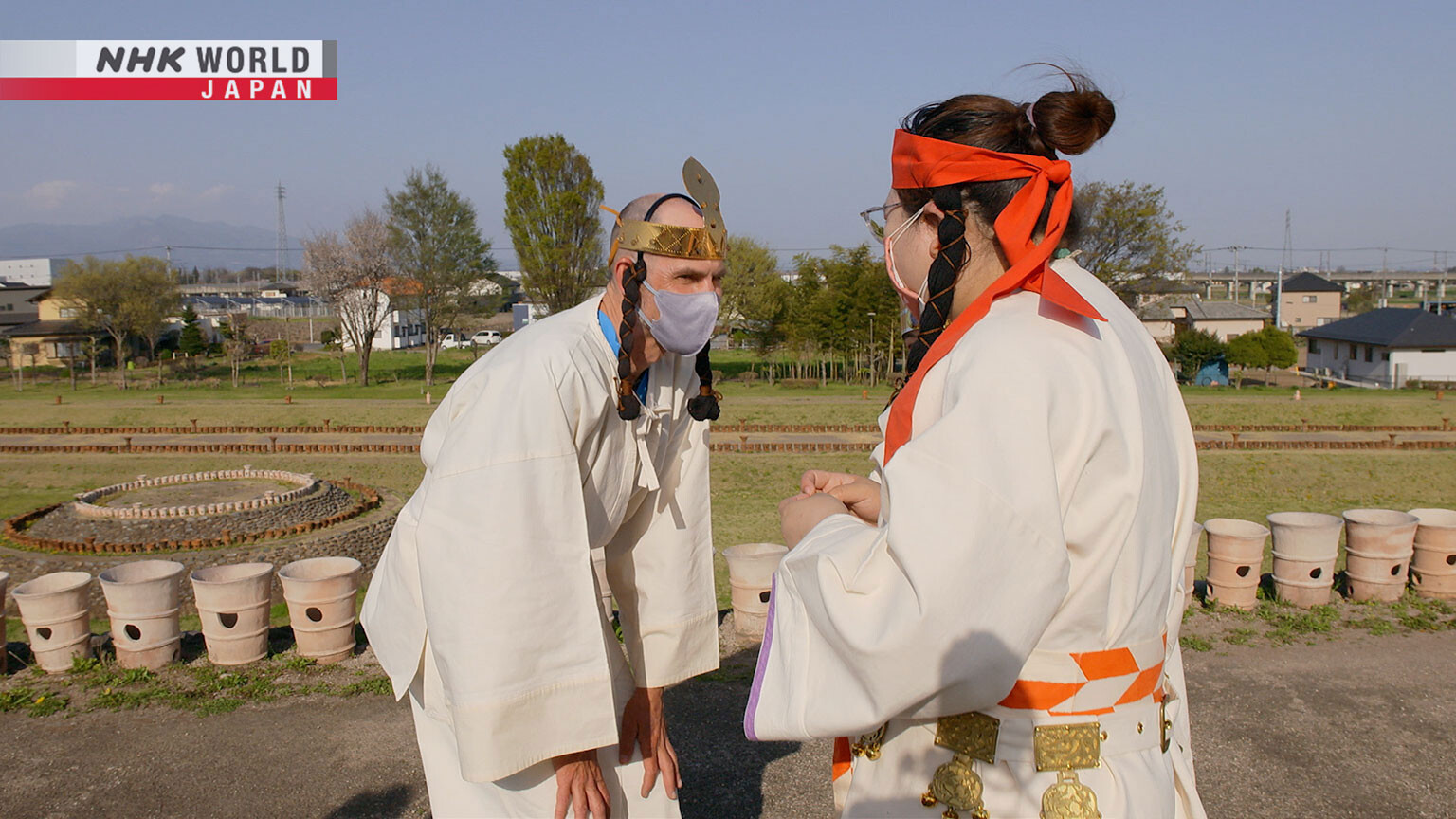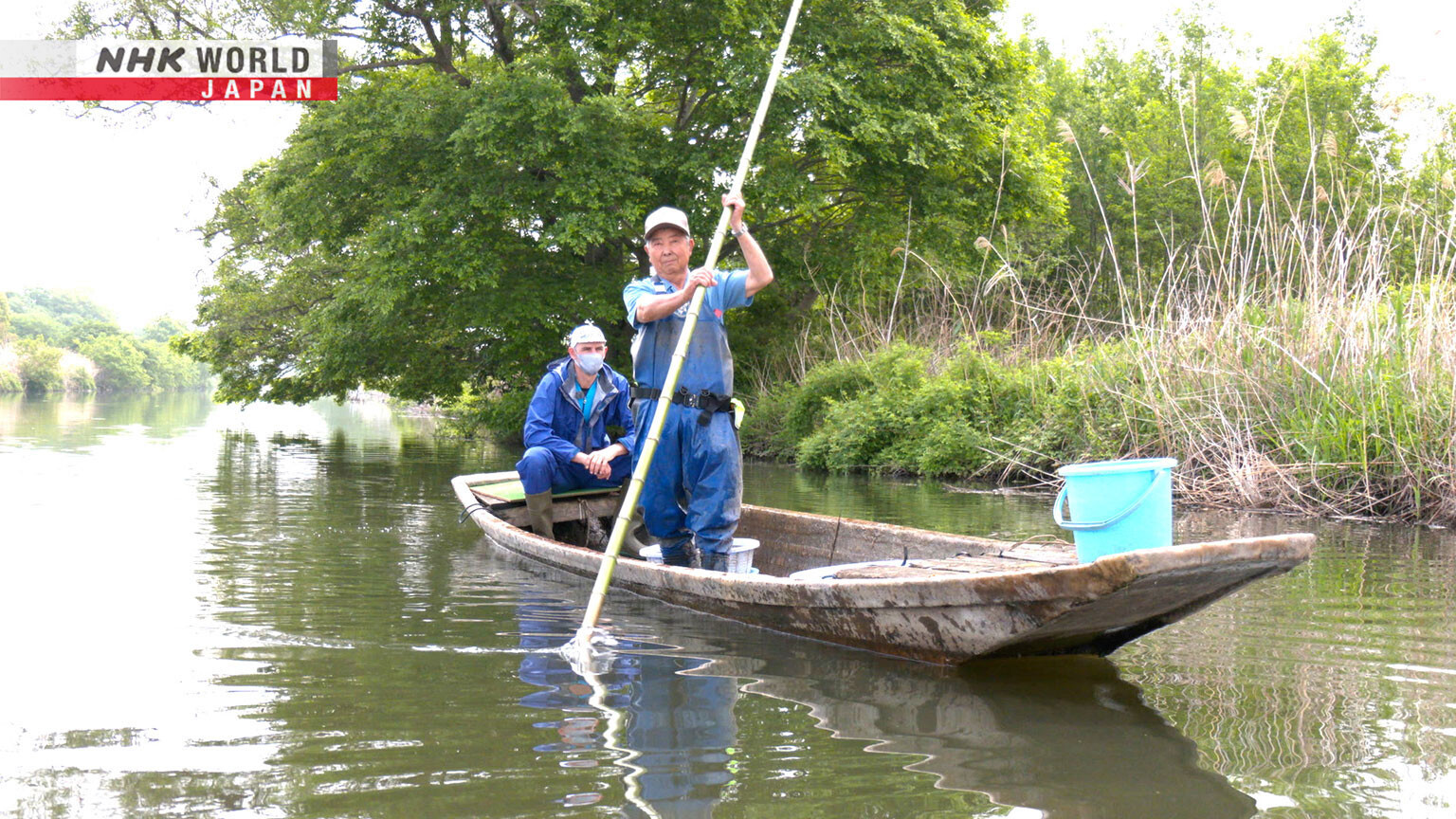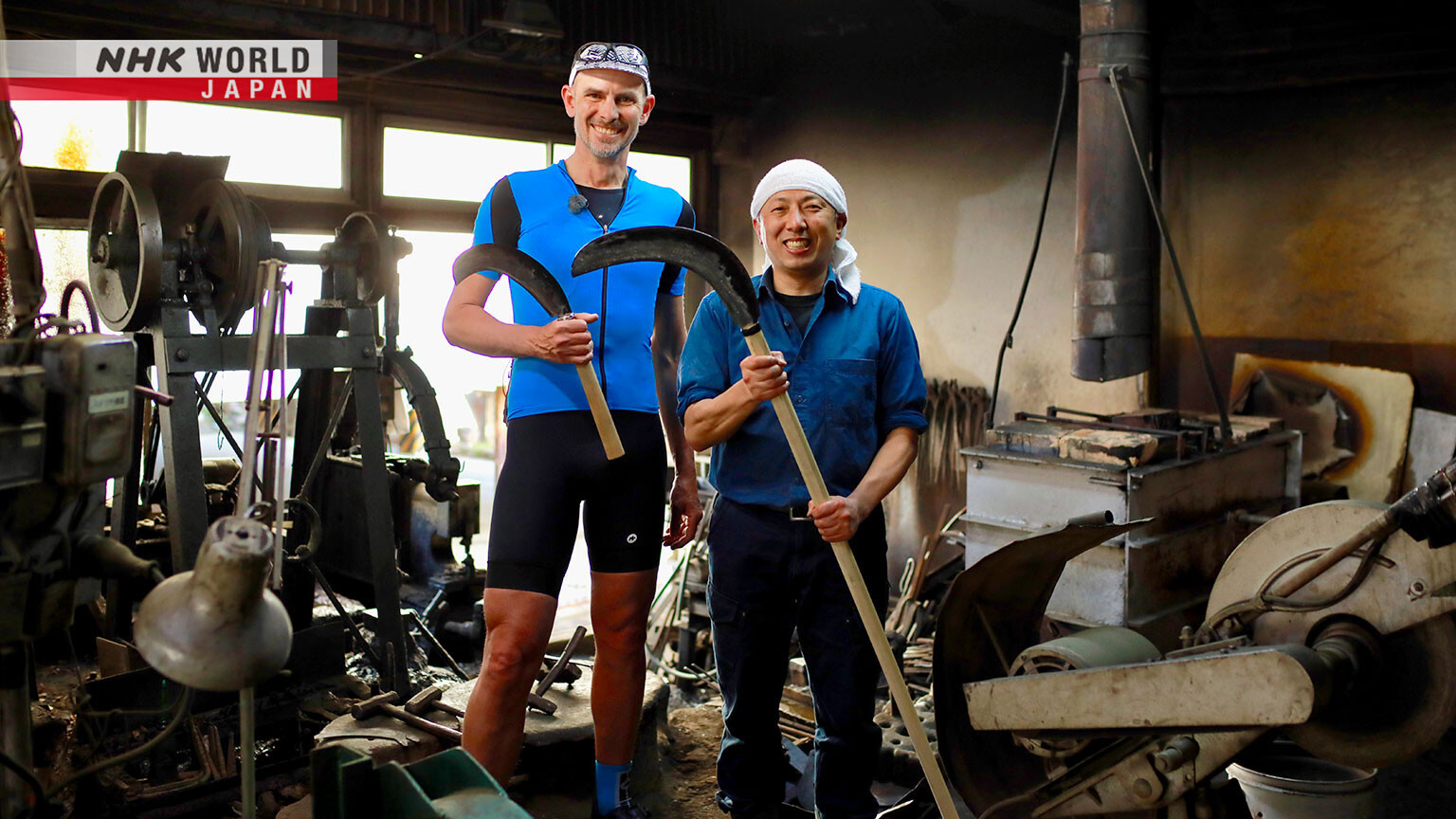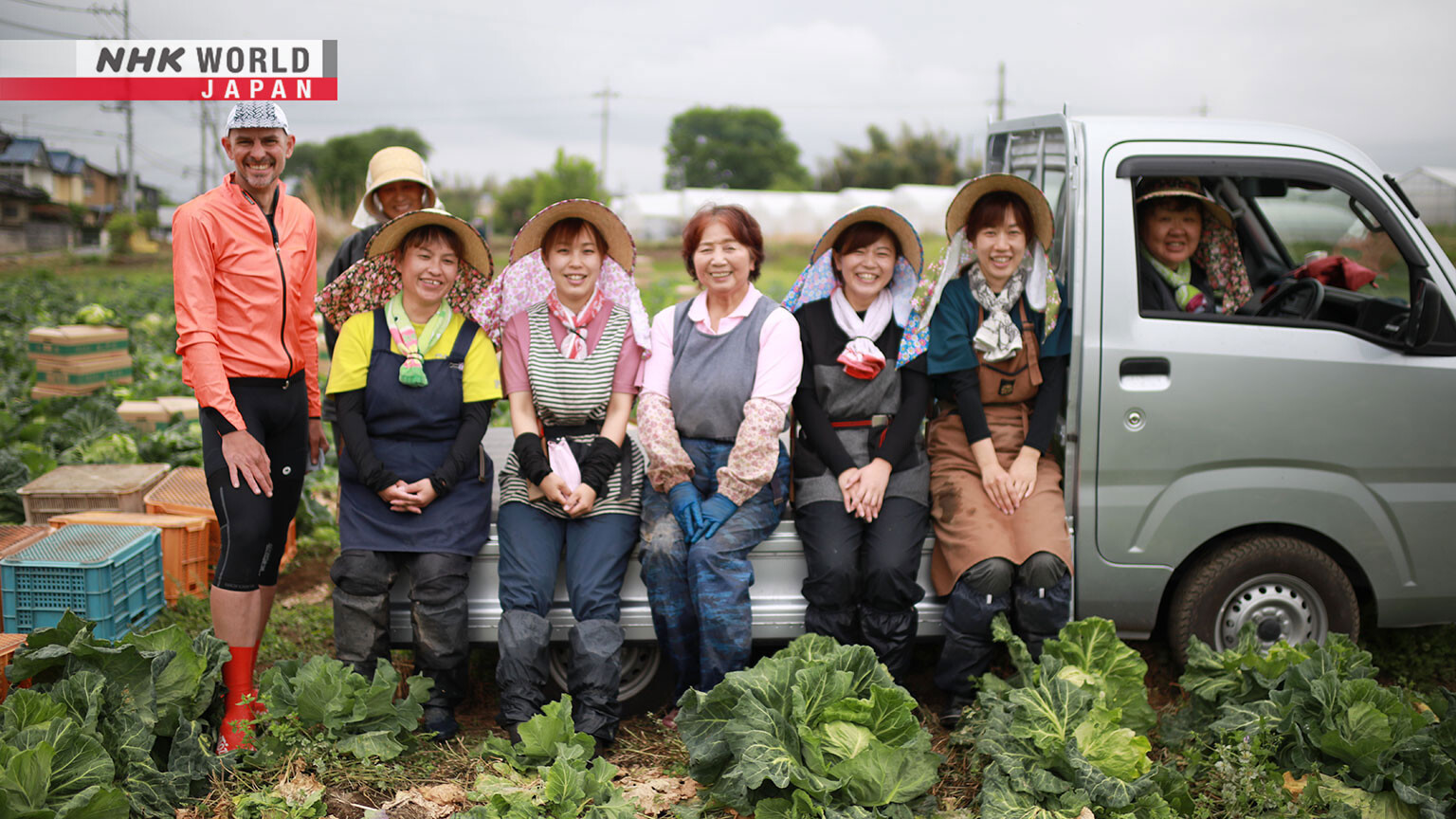Gunma - An Unstoppable Energy
In early spring, Australian cyclist Zac Reynolds rides through Gunma Prefecture. Starting from the capital Maebashi, he sees a 5th century ritual atop an ancient king's burial mound before cycling up the Tone River to Itakura, famous for its catfish. In Kanna-town, he meets a master blacksmith whose hand-crafted blades are in demand nationwide. Finally, in the mountain village of Nanmoku, he talks with a young man revitalizes the area backed by the encouragement and advice of its energetic elderly inhabitants.




Transcript
The best way to discover little-known sights,
and make even familiar places feel brand new, is to go exploring by bicycle.
Spring has just arrived, and we're off to explore Gunma.
Gunma has its famous sights, but it has many hidden attractions too.
This is an area known for its powerful womenfolk.
It's delicious!
Gunma was once home to an ancient culture.
We pray this prosperity continues.
Still going!
Here, we'll find mountain roads steep enough to challenge the toughest cyclist.
And artisans who never stop pursuing excellence.
The true value of a tool is in its use.
I'm always happy to be told they work well.
People here don't seem to slow down with age - they only get more enthusiastic about life.
Come with us now, on a 380-kilometer ride through Gunma.
Gunma is situated in the center of Japan's main island of Honshu.
It's home to about 1.9 million people.
We start our ride in Maebashi, the prefectural capital.
It's the perfect time of year for riding.
It's, you know, coming out of winter, warming up a bit, and maybe the cherry blossoms will still be blooming.
We'll see!
Zac Reynolds moved to Japan from Australia in 1998.
After a long career in professional racing, he's started to slow down a bit, and now cycles mostly for pleasure.
So this is my bike for the trip.
I've got a couple of changes of clothes in the back here,
and stuff I use along the way in this little bag here.
So what I usually use are a little towel, sunscreen, a bottle of coffee on the way...
...and this is my snacks for my ride.
I make some muesli bars whenever I can.
Energy bars made with oats and dried fruit - Zac's standby on long rides.
OK, the bike's ready.
Let's go!
Our four-day ride begins with a visit to a gigantic ancient burial site.
Day two takes us east along the Tone River, to catch the sights and tastes of spring.
On day three, we visit Kanna, in Gunma's western mountains.
And on the last day, we explore the remote area around Nanmoku.
Zac sets off on the road that will take him from Maebashi to the neighboring city of Takasaki.
Quite a wide tree-lined avenue here.
It's quite a big city.
My image of Gunma is mostly mountains.
I haven't been to Maebashi before, but it's quite a big city.
A beautiful row of willow trees.
It's quite a fast flowing river through the middle of town.
These rushing waters originated as snowmelt high up in the mountains.
Hello!
There's a lovely old wooden bridge here.
Such bridges are a rare sight these days.
Look at the colors of this train.
The old Sano Bridge has been lovingly restored many times over the years.
Beautiful! Perfect timing.
Zac has arrived just as the cherry blossoms have come into full magnificent bloom.
Oh wow, look.
Over there you can see a couple of big mounds.
You can see how big it is.
This ancient burial mound was the tomb of a king who lived in the 5th century.
It's been reconstructed and is now a public park.
In that period, rulers demonstrated their power by building huge tombs, known as "kofun."
Gunma was then one of the most prosperous parts of eastern Japan,
and the remains of about 14,000 of these "kofun" mounds have been found here.
Over here we've got a lot of earthenware figures.
These are reproductions of "haniwa" clay figures, buried with the dead,
and thought to have been used to appease and protect their spirits.
They provide important insights into ancient life and religious rituals.
On top of the mound, Zac is going to meet someone who will explain the site.
Well, that looks like it.
So this might be the guide, or it might be the king from below come back to life.
Looks like some kind of ceremony happening here.
This is a local group who recreate ceremonies from the days when the mound was built.
It's thought that one function of these mounds was to provide a stage for such rituals.
- Hello. Pleased to meet you.
- You're welcome.
- Those are great costumes.
- Thanks. We like them.
- You make them yourselves?
- That's right.
Kuribara Teruhiko plays the part of the king who was buried here.
So you're the king. Who are the others?
I'm a member of the royal house.
And I'm the king's shaman.
I'm an envoy from the Yamato kingdom.
The group has around 40 members.
They come from all walks of life, and range from teenagers to pensioners.
They perform this ritual at a festival held here once a year.
Characters, costumes and props are all based on the latest archeological research.
The design of this shield is based on an excavated "haniwa" clay figure.
The zigzag pattern wards off evil spirits,
so we carry this shield in front of the group.
To protect the king.
Every detail is made as accurate as possible,
to help the audience imagine they are there at these ancient scenes.
Such fine detail!
This place has such a deep history.
I want to share it.
Anytime you're ready!
They put on this special full-dress rehearsal just for us.
The king gives thanks to the gods, and prays for the prosperity of his people.
Look upon the beauty of our land.
Its green mountains, its clear streams.
Golden fields that promise a bountiful harvest.
Kuribara and his group rehearse here throughout the year.
Memorizing these lines, I think
about the king as he built his country.
How he planned this kingdom
so his people could be happy and prosper.
Our farmers happily work the fields.
Our storehouses overflow with food.
We pray this prosperity continues.
Thank you very much. I can imagine
the actual festival must be very impressive.
Practicing right here on the mound
gets you into the spirit of the place.
So I come up here every morning to rehearse.
You have to laugh, but I've been reported
as suspicious by people walking their dogs.
A glimpse into the mind of an ancient people.
We're getting out of the flat plain in the center of Gunma, rising up a little bit towards Akagi san.
This wide plain on the road to Mount Akagi is prime farming land.
It started out blue and clear this morning, but as always,
the closer you get to the mountains, the more chance there is of rain.
Some cabbages here on the left, some more on the right.
Near the foothills of Mount Akagi, the main crop is now cabbages.
Looks like they're doing some harvesting here.
Let's stop and have a look.
- Hello! Are you getting in the crop?
- That's right.
These are spring cabbages.
April is harvest time for this variety of cabbage.
They're very tender and tasty,
but only available for a brief period in spring.
Aoki Akemi began growing cabbages about 40 years ago, and now runs a quite extensive farm.
In this season, she will harvest 2,500 cabbages a day.
Aoki hires local housewives to help with this intensive work.
They're all mothers, with kids
in school or kindergarten.
They manage to do this at the same time as bringing up children.
Emi! Come over here.
Working for Aoki is great because we can
easily take time off if our kids need us.
We might get a call saying a child has a fever.
No problem - they can just go straight home.
I don't mind being flexible about such things.
We know we can always trust her,
so we relax and enjoy working together.
Gunma is famous for its dry blustery winds,
and for its no-nonsense tough women.
We're not afraid of hard work, that's for sure.
Akagi spring cabbages are known for their juiciness and sweet taste.
- I eat this part?
- Yes, just take a big bite.
Very tasty. Not bitter at all.
- It's very tender.
- Tender and sweet.
Tatsutoshi!
Aoki's husband Tatsutoshi.
They've been married 50 years.
She's the boss!
Yes, I just do what she says.
I can't think of anything better than
working together as a couple like this.
These young mothers are so healthy and active.
Full of life, and loving it.
Children thrive when their mums are happy.
So I feel I'm helping everyone with this work.
You have to be cheerful, and tough, to be a mother in Gunma.
Fantastic cycling path along the river.
Nice cool breeze.
This cycling route runs beside the Tone River for 88 kilometers.
Look at this big field of yellow flowers.
It looks like canola flowers or rapeseed flowers.
It's really a colorful season.
We're now in Itakura, a town on the Tone River.
What an impressive shrine up here too.
The Raiden Shrine is said to have been founded in 598.
Oh wow, look at this catfish.
It's a big bronze catfish. Look at the whiskers on it.
Catfish are an Itakura specialty.
This statue shows how important they have always been to the people of this area.
- Hello! Do you live around here?
- Yes. I just dropped by to pay my respects.
- I've never seen a catfish like this.
- It's quite rare.
Does it have any special meaning?
It's a way our local fishermen showed their
appreciation for the fruits of the river.
Do you still catch catfish here?
Oh yes. They say it's lucky for visitors
to eat catfish tempura before they leave.
Zac's been told he'll find a catfish fisherman on a nearby river.
That looks like some kind of kite or hawk.
Maybe going fishing in the river there.
Part of the Tone river system, Itakura's Yata River has always been famous for its plentiful catfish.
Ah. Looks like it's just over here.
Hello!
- Are you fishing for catfish?
- That's right.
- Can I come and watch?
- Sure. Come aboard.
Masuda Takashi has been fishing on this river for nearly 60 years.
I see your boat has no motor.
Yes, I use this bamboo pole.
Spring is the start of the catfish season.
It's so quiet and peaceful.
I hear birdsong and frogs croaking.
- Is that your net?
- Yes.
It looks heavy.
Wow, it's so long. It keeps on coming.
Masuda has 30 of these nets along the river bank.
Looks like an eel in there, and a couple of prawns as well.
These are freshwater prawns.
- Can you eat them?
- Oh yes. They're great deep-fried.
Sounds delicious.
These little ones are goby. Very tasty.
Another kind of goby. These grow bigger.
- Did you make the net yourself?
- Yes.
It's a type we call a hell net.
Inside the big net are four smaller ones.
This is a traditional fishing technique.
The deeper a fish swims into the layered nets inside, the harder it becomes to escape.
Catfish were once a major source of protein here, but tastes changed and few fishermen are left.
Masuda loves this work and never plans to stop.
He's still out on the river every day.
After all these years, I have
an instinct for where the fish will be.
I fish this river all year round,
so I know every corner of it.
Catfish like to avoid the light,
so shady spots are the best places for the nets.
This time you've got some big ones.
- Are these catfish?
- Yes.
They're very slippery.
It's a big one. Looks heavy.
It looks pretty much the same as the statue we saw at the shrine.
You never know if you have any fish
until you haul up the net. It's always exciting.
I see why you come out every day.
This Itakura restaurant attracts many visitors with its catfish menu.
It's been serving river fish of all sorts for 120 years.
The most popular dish on the menu is their deep-fried whole catfish.
It's accompanied by catfish, bones and all,
chopped up and mixed into balls with tofu, carrots and burdock, then deep-fried.
The chef is always happy to introduce visitors to local ways of eating catfish.
Here you are.
Wow! So big!
Deep-fried, whole fresh catfish.
A little bit of sauce.
It's a fairly light flavor.
Sometimes river fish has a distinctive flavor, but that doesn't have much, much of that at all.
It's really good.
What a treat - a whole catfish
just for me. It tastes delicious.
For those who live in Itakura, catfish will aways be the taste of home.
It's really nice and peaceful out here.
Quite a bit higher up, so you get a good view of the dam too.
Coming into a little town here.
I wonder if this is the main part of Kanna town.
Many villages lie along the Kanna River, another part of the Tone river system.
Hamono kobo.
Looks like a blacksmiths.
Nice little bike in there.
Check this out.
Hello! Anyone there?
- Are you the blacksmith?
- That's right.
- Is it OK if I come in and take a look?
- Sure.
Amano Ken is the fourth generation of a family that have been blacksmiths here for over 120 years.
He makes everything from farm tools to kitchen implements.
Looks like he's making a couple of different things at the same time, sort of heating them,
and then sort of shaping one while he's heating the other and then putting one back in and then shaping the next one.
Amano gets orders from all over Japan for tools that can't be mass produced and need an artisan's skills to make.
How many different tools do you make?
I don't know, there are so many.
Probably as many kinds as I have customers.
Ah, here's an interesting tool.
- What is it used for?
- It's for deer hunters.
Only this inside part is sharp.
They make a hole under the throat
and then pull down to expose the guts.
The special shape of this knife lets a hunter slice an animal's skin open without rupturing the organs inside.
Amano's ruling passion is to craft unique tools for each customer's needs.
He forges each blade to match both the physique and the personality of the person who will use it.
The curved shape of this machete-like knife makes it light and effective at cutting.
Amano invites Zac to try it out...
You learn fast.
A good tool makes a clean cut.
My father said you must use tools yourself
if you want to understand their design.
He made me work in the fields to figure out
the reason for each blade's shape and angle.
Amano had always watched his father Katsuo at work.
He began his own training at age 25.
His father kept working in the smithy until he passed away at 69.
He wasn't afraid of dying.
But he was worried about not being able to work.
He said he was happy knowing
that his tools would live on after him.
What makes me really happy is when
people tell me my tools do the job well.
Tools should be used - that's what they're for.
Of course I am happy when people praise my tools.
The flame of a father's passion burns on in the son.
For his last day, Zac has come to the western edge of Gunma, to the village of Nanmoku.
Coming down into the village now.
Wow, look at this view!
Good morning!
Big ravine there, with the river coming through it.
Nanmoku was once a very prosperous area.
Its wealth was based on the cultivation of silk and "konnyaku."
Today the population has fallen to around 1,600, and the average age is 68.
This village is aging faster than anywhere else in Japan.
Someone should be waiting to meet Zac down in the village.
It should be in here.
Ah, this looks like our guy.
Hello!
- It's Sato san, right?
- That's me.
Pleased to meet you.
- You look so young!
- Well, I'm 27.
Sato Yuta came here three years ago.
At first, he worked as a volunteer with a regional revitalization group.
He's now moved on to engage in a number of new projects, working closely with the villagers.
- My job today is Mokumeshi.
- What's that?
It's our food delivery service.
The service started two years ago, after the COVID pandemic hit.
It allowed local restaurants to send freshly prepared meals to customers who had stopped dining out.
Look at the houses.
It's like they're stacked up one on top of the other, up on these rock walls.
Imagine the hardships of life up here, so far up in the mountains.
Over the centuries, local farmers built stone walls to create space for houses and fields on these steep slopes.
The result is a hill-climber's dream.
This is certainly my exercise for the day.
- It's up here, Zac.
- I'm coming!
Still going up.
We're in Hoshio, the most remote part of the village.
That's the hardest ride since I stopped racing.
I don't do this kind of cycling anymore.
Hello! I've brought your meals!
Excuse me! He's brought a visitor too.
- Here are your bento lunches.
- Thank you for coming all this way.
It must be convenient, getting meals delivered.
You wouldn't expect this service,
way up here in the mountains.
We're so grateful for these deliveries.
- You live in a beautiful spot.
- It's very high.
In the village below they say
we must look down on the crows as they fly.
Unbelievably, Ichikawa Genzo is 80 years of age.
Living his whole life in this village, he's a walking encyclopedia of the area.
Things we grow up here might not look so good,
but they are really tasty.
That's what I like best about mountain life.
Sato is grateful for the many insights into life he's gained by listening to the villagers' tales of the old times.
Living here feels like I gained
a whole set of great new grandparents.
It's a great thing for the village when
serious young people like Sato come to live here.
- He's made everyone very happy.
- I just try my best.
Last year, Sato engaged in yet another new business.
This is his mentor, Ito Shinichi.
Ito's business is converting abandoned farmland for flower cultivation.
He's found certain varieties that thrive very well in this area.
We grow these to use as Christmas wreaths.
Ito is happy to teach his young apprentice everything he's learned over years of trial and error.
I worked long and hard to gain the knowledge
I have, and I want to pass it on.
His job will be to adapt things
to suit the times.
Sato continues to discover fresh potential in the knowledge and experience of these elderly villagers,
a wisdom that shows no sign of fading with age.
These villagers don't seem old at all.
They're always keen to start something new.
This may be the fastest aging village in Japan,
but that's because they all want to live long.
Old, but full of life.
Japan's oldest, but most energetic village.
I'm heading for our goal today in the major peak surrounding the central Gunma area, Mount Myogi.
There's a spot up here with the best view of Mount Myogi, and that's where we'll end this trip.
At least we've got a view. Look up here.
Sheer cliffs with these little jagged boulders.
Ah, here we are.
Look at these jagged peaks up here.
Wow, that's awesome.
This is Mount Myogi.
It took millennia of erosion to create this rocky landscape.
A perfect finish to the trip.
From the people I've met on this trip, you could sense the passion for improving.
And, thinking about how to make things better is also an important part of sort of continuing the tradition.
Seeing these people who've been working for 30 or 40 or 50 years at the same career,
from the catfish fishermen or the couple growing the cabbages to the blacksmith as well.
There's a lot of experience there that can't be copied by technology these days.
And just the energy that they still have,
and the feeling that they have for where they live and life is not over for them, even though they're 80 years old.
It just gives you sort of an enthusiasm to continue growing myself.
The old folks of Gunma and their passion for living - an inspiration to any cyclist thinking about the next phase of their life.